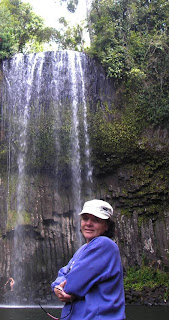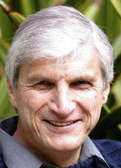 On turning 65, one can’t help feeling both regret and joy: regret at being old enough to be 'pensionable' and joy at being not yet dead.
On turning 65, one can’t help feeling both regret and joy: regret at being old enough to be 'pensionable' and joy at being not yet dead.In my case, I actually thought I had another day to go (a miscalculation possibly caused by the enervating Mt Isa heat or unconscious denial, or both).
Birthday bash at Tod and Clare Hirn's home.
I even had Carol convinced. It was only when my mobile phone erupted with congratulatory text messages from family that we both realised this was indeed 29 August.
It also happened to be the day of a dinner date with my niece Clare Hirn (brother John's 8th child) and her energetic and resourceful husband Tod, who together run Mt Isa’s No 1 floor coverings store, Hirn’s Carpet Choice.
We hadn’t seen them since their wedding in July last year in Maleny on the Sunshine Coast hinterland.

Tod generously shouted us to Italian cuisine at swishy Dom’s restaurant, where the four of us – or rather five, as Clare is eight months pregnant – raked over the joyful and tragic events of the past.
Birthday boy with Clare and Tod.
It was an unforgettable evening.
Clare and Tod have just finished renovating their home, tucked in behind but separate from their showroom in Mt Isa’s main street – a pretty handy setup for when baby arrives.
For our final night, Clare cooked up a curry and baked a chocolate cake lit up with a lone candle (a la the Mt Isa chimney stack) that I struggled to blow out.

We were really sorry to say goodbye – they are among the sweetest people you could possibly meet and somehow have managed to strike a good work-life balance.
Carol and Clare talking babies.
We found Mt Isa (population 23,000) a hot, busy place with a cityscape dominated by the Xstrata copper mine’s giant chimney stack and slag heaps. It operates 24x7 and employs 4,500 people.
Lead dust from the slag is a local health issue, but everyone knows that if the mine stops the town dies.
Dog day afternoon

En route to Mt Isa, we stayed overnight in Cloncurry after hauling our van around 450 kilometres south on the Matilda Highway from Karumba in the Gulf.
The big mine smokestack dominates the Mt Isa landscape.
We had intended staying overnight at the Burke & Wills Roadhouse around halfway, but made such good time that we decided, after a quick lunch, to keep going.
We were out of autogas, and as the autogas pump at Burke & Wills was out of order, we switched to petrol for the final 180-odd kilometres to Cloncurry, where we booked into a caravan park and stayed hitched for an early morning departure.
In the late afternoon we went for a walk along the Barkly Highway west towards town to check out the information centre.
Man's best enemy
That was when we had our encounter with the dog. Well, some may call it a dog, but it was more like a cross between a pit bull and a horse.

Downtown Cloncurry, a place pretty much gone to the dogs.
It came bounding out of an unfenced yard snarling in a most unfriendly manner. We backed off, making soothing noises, but the dog lunged forward and sank its teeth into my left hand.
We decided to walk on a couple of hundred metres to the information centre to get help as my hand was bleeding quite a bit.
The centre was closed so I washed up at a filthy public toilet, cursing and soliloquising like Lady Macbeth (‘will these hands ne’er be clean?’).
On the way back, a woman driving a Toyota 4WD ute covered in red dust saw our predicament, kindly squeezed us into the front seat with her shopping bags, and took us to the local hospital, located luckily quite close to the van park, to get the wound dressed.
There a woman wearing an enormous stethoscope who looked far too young to be a doctor insisted on my having a tetanus injection and antibiotics “because a dog’s mouth has bacteria that can cause serious infection”.
I meekly complied, remembering well the loss of a sibling to sudden infection.
As we were leaving early, the caravan park proprietor promised to report the incident to the local council, which is having a blitz on out-of-control dogs. I hope they penalised the owner and not the dog.
It was a salutary introduction to the Queensland outback.
After leaving Mt Isa, aided by a strong tail wind, we travelled west on the Barkly Highway stopping after 200 kilometres at Camooweal for fuel and then, 250 kilometres further west at Barkly Homestead in the Northern Territory for an overnight stay. This blog entry comes from Barkly Homestead. We plan to briefly visit Tennant Creek, which is another 200 kilometres west, before taking the Stuart Highway north to Darwin.




















































